2A M3U3 In the kitchen(课时教案)牛津上海版(试用本)
M3U3 In the kitchen 课件-二年级上学期英语(牛津上海版试用本)
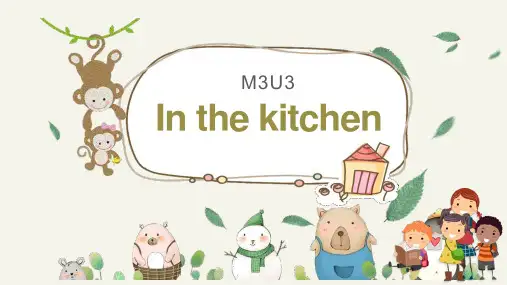
Look and learn
chopsticks
ck /k/
- How many chopsticks?
duck chick lock knock quick
- There is a pair of chopsticks.
Let’s practice!
Which one is bowl?
Let’s practice!
dinner
give sb. sth. = give sth. to sb. 给某人某物
ready:准备 Dinner is ready! 晚餐准备好了!
Enjoy a story
Ginger
复习: in on-under
How does Ginger feel? 害怕!!!
2.There three pencils on the desk. A.am B.is C.are
3.There a pen and three rubbers. A.am B.is C.are
- How many bowls? - There are four bowls.
+
=
- How many plates? - There are six plates.
plate
a_e /eɪ/
bake cake date gate hate late mate make rate shake wake
Look and learn
- How many spoons? - There are five spoons.
spoon
oo /uː/ boots food moon noon root school
Which one is spoon?
Module 3 Unit 3 In the kitchen Period 1 教案
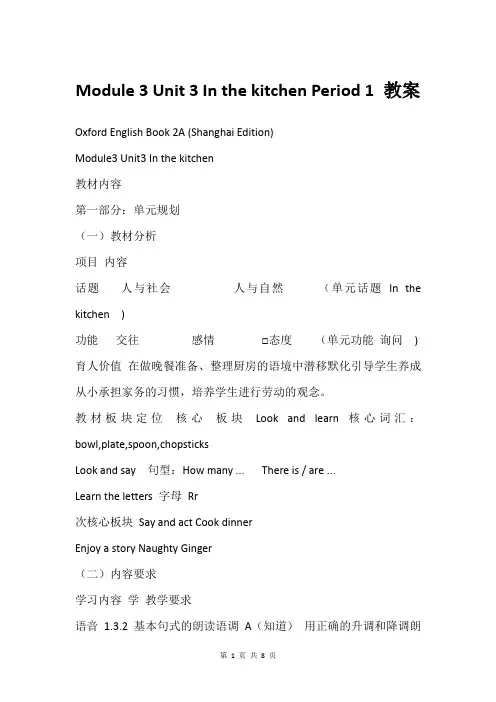
Module 3 Unit 3 In the kitchen Period 1 教案Oxford English Book 2A (Shanghai Edition)Module3 Unit3 In the kitchen教材内容第一部分:单元规划(一)教材分析项目内容话题人与社会人与自然(单元话题In the kitchen )功能交往感情□态度(单元功能询问)育人价值在做晚餐准备、整理厨房的语境中潜移默化引导学生养成从小承担家务的习惯,培养学生进行劳动的观念。
教材板块定位核心板块Look and learn 核心词汇:bowl,plate,spoon,chopsticksLook and say 句型:How many ... There is / are ...Learn the letters 字母Rr次核心板块Say and act Cook dinnerEnjoy a story Naughty Ginger(二)内容要求学习内容学教学要求语音1.3.2 基本句式的朗读语调A(知道)用正确的升调和降调朗读基本句式词汇2.1 核心词汇C(运用)理解和运用核心词汇句法 4.2.2.2 特殊疑问句C(运用)用特殊疑问句提问,并作出回答语篇5.1.1 记叙文基本信息A(知道)简单讲述对话、故事等记叙文中的时间、地点、人物、事件等基本信息(三)学情分析内容知识要点教材栏目学生基础活动选择语音陈述句的朗读语调特殊疑问句的朗读语调Say and act Look and say 熟知略知新知倾听、模仿、跟读、朗读...词汇餐具类词汇:bowl,plate,spoon,chopsticks Look and learn Look and say Say and act 熟知略知新知倾听、模仿、跟读、朗读...句法句型:How many ... There is / are ... Look and say Enjoy a story 熟知□ 略知新知倾听、模仿、朗读、问答...第二部分:单元整体设计主题与话题单元教学目标与单元语用任务【单元教学目标】知识与技能能在语境中感知朗读陈述句和特殊疑问句的正确语调。
牛津上海版试用本英语四年级上册Module 3 Unit 3In theshopPeriod 1课件
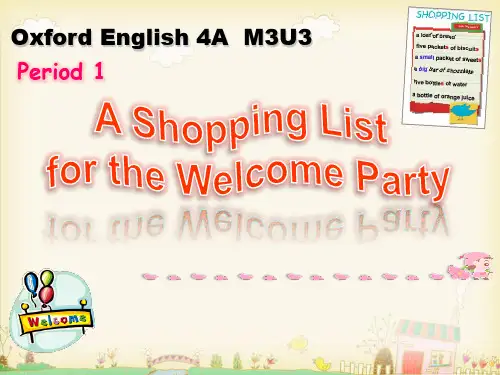
发纸条 加关注
博客等级:18 博客积分:2580 博客访问:63,815 关注人气:125
Dear friends,
Please come to Jill’s Welcome Party.
Time: 2.00 p.m. Saturday (20th Oct.)
Place: Building 7, 123 Park Road Yours, Kitty
a bar of chocolate
What?
How many? I need __________________.
Why?
Because _______________.
shopping list
a loaf of bread five packets of biscuits a packet of sweets a bar of chocolate five bottles of water a bottle of orange juice
图片
关于我
Let’s have a welcome party for Jill. 2012. 10. 9.
Invitation
加好友 写留言
发纸条 加关注
博客等级:18 博客积分:2580 博客访问:63,815 关注人气:125
Dear friends,
Please come to Jill’s Welcome Party.
I’m happy. Because I have a new friend. Her name is Jill. She likes orange juice best. She can sing and dance well. She is so nice. We all like her. I want to have a welcome party for her.
Module3Unit3Inthekitchen(教案)牛津上海版(试用本)英语二年级上册
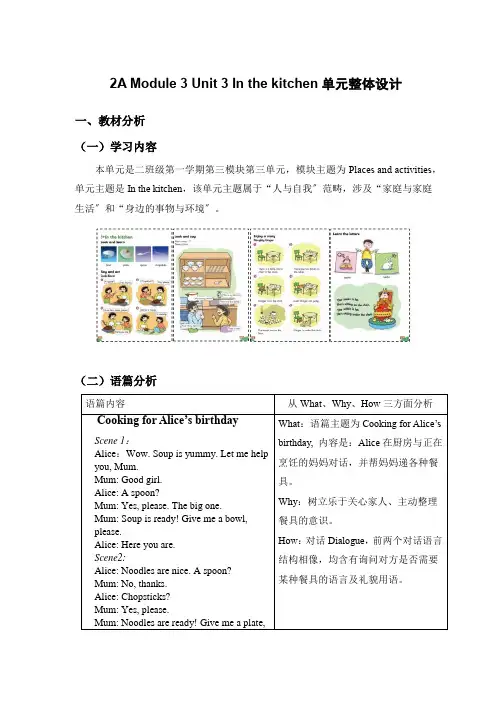
2A Module 3 Unit 3 In the kitchen单元整体设计一、教材分析(一)学习内容本单元是二班级第一学期第三模块第三单元,模块主题为Places and activities,单元主题是In the kitchen,该单元主题属于“人与自我〞范畴,涉及“家庭与家庭生活〞和“身边的事物与环境〞。
(二)语篇分析(三)教学内容分析二、学情分析二班级同学已在此前学习过与食物有关的词汇,会用简洁的形容词描述食物;已学习仿照运用核心句型How many…?询问物品的数量;已学习仿照运用核心句型Give me a…Here you are. Thank you.懂得根本的社交礼仪与日常问答。
以下是学情分析表:三、教学目标 〔一〕单元目标● 学问与技能1. 能知晓、背记字母 Qq, Rr 的音、形及其在单词中的根本读音,并能正确书写;能朗读含有字母 Qq, Rr 的相关单词和儿歌。
能用降调朗读特别疑问句How many…?和陈述句 There is/are...。
2. 能在语境中听、读关于厨房餐具类单词 bowl, plate, spoon, chopsticks ,并能说出这些餐具的名称,知晓他们的复数形式。
3. 能在语境中仿照运用核心句型How many…?询问物品的数量,并做出应答。
能用There is/are...对物品的数量和位置进行描述。
4. 能在语境中听懂、读懂 Look and say, Say and act, Enjoy a story 等教材板块中的对话和故事的意思,猎取相关根本信息,并能尝试进行对话和故事表演。
● 思维与策略在课堂学习和沟通中仔细倾听,乐于仿照,乐观思索,并尝试运用所学语言学问进行表达和沟通。
● 文化与情感树立在家长烹饪时乐于关心、主动整理餐具的意识,同时,初步感受餐具文化,了解根本的餐桌礼仪。
● 单元语用任务在“In the kitchen 〞的相关语境中,能询问及答复所需的餐具、询问及答复餐具的数量,及描述餐具所在的位置。
4AM3U3-In-the-shop教案
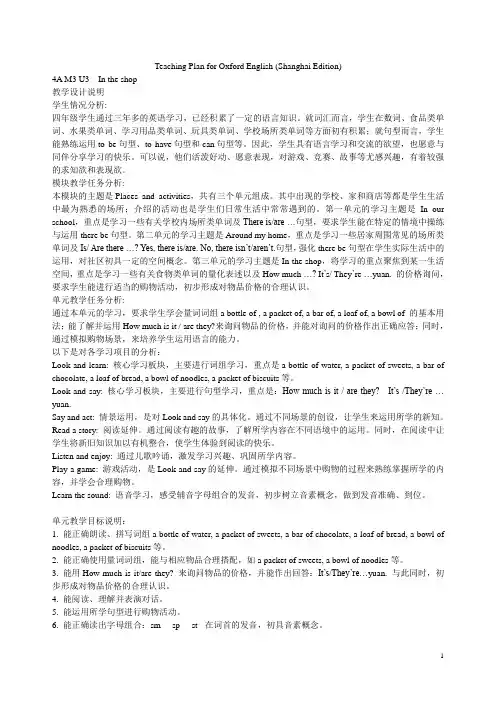
Teaching Plan for Oxford English (Shanghai Edition)4A M3 U3 In the shop教学设计说明学生情况分析:四年级学生通过三年多的英语学习,已经积累了一定的语言知识。
就词汇而言,学生在数词、食品类单词、水果类单词、学习用品类单词、玩具类单词、学校场所类单词等方面初有积累;就句型而言,学生能熟练运用to be句型、to have句型和can句型等。
因此,学生具有语言学习和交流的欲望,也愿意与同伴分享学习的快乐。
可以说,他们活泼好动、愿意表现,对游戏、竞赛、故事等尤感兴趣,有着较强的求知欲和表现欲。
模块教学任务分析:本模块的主题是Places and activities,共有三个单元组成。
其中出现的学校、家和商店等都是学生生活中最为熟悉的场所;介绍的活动也是学生们日常生活中常常遇到的。
第一单元的学习主题是In our school,重点是学习一些有关学校内场所类单词及There is/are …句型,要求学生能在特定的情境中操练与运用there be句型。
第二单元的学习主题是Around my home,重点是学习一些居家周围常见的场所类单词及Is/ Are there …? Yes, there is/are. No, there isn’t/aren’t.句型,强化there be句型在学生实际生活中的运用,对社区初具一定的空间概念。
第三单元的学习主题是In the shop,将学习的重点聚焦到某一生活空间,重点是学习一些有关食物类单词的量化表述以及How much …? It’s/ They’re …yuan. 的价格询问,要求学生能进行适当的购物活动,初步形成对物品价格的合理认识。
单元教学任务分析:通过本单元的学习,要求学生学会量词词组a bottle of , a packet of, a bar of, a loaf of, a bowl of 的基本用法;能了解并运用How much is it / are they?来询问物品的价格,并能对询问的价格作出正确应答;同时,通过模拟购物场景,来培养学生运用语言的能力。
Module3Unit3Inthepark(教案)牛津上海版(试用本)英语三年级上册
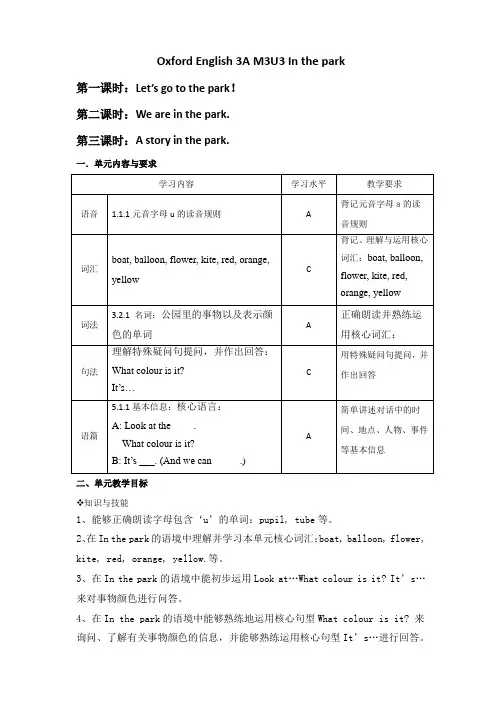
Oxford English 3A M3U3 In the park第一课时:Let’s go to the park!第二课时:We are in the park.第三课时:A story in the park.一.单元内容与要求二、单元教学目标❖知识与技能1、能够正确朗读字母包含‘u’的单词:pupil, tube等。
2、在In the park的语境中理解并学习本单元核心词汇:boat, balloon, flower, kite, red, orange, yellow.等。
3、在In the park的语境中能初步运用Look at…What colour is it? It’s…来对事物颜色进行问答。
4、在In the park的语境中能够熟练地运用核心句型What colour is it? 来询问、了解有关事物颜色的信息,并能够熟练运用核心句型It’s…进行回答。
5、在In the park的语境中能够尝试运用can, row a boat, smell the flower, swing, nice, fun, happy等词汇描述在公园中的快乐活动。
❖文化与情感通过在In the park语境中的学习,来激发学生热爱自然、亲近自然的品质,体验公园玩乐中的快乐。
❖学习策略1、通过听说读的方式,以语篇语境带动核心词句的学习。
2、以师生交流、生生交流的方式初步运用核心词汇和句型。
3、以角色扮演活动、小组交流活动等方法,进一步运用核心词汇和句型。
4.通过表演、描述等法,综合运用核心词汇和句型,提高语用能力。
【教学重难点】围绕在In the park的语境,熟练运用Look at…What colour is it? It’s…来对事物颜色进行问答,通过学习激发学生热爱自然、亲近自然的品质, 通过学习体验公园玩乐中的快乐。
三、学情与教材分析四.单课教学目标五、单课时的文本内容与教学过程Period 1 Let’s go to the park!一、第一课时文本主体学习文本:Let’s go to the park!Dad: Do you like the park?Kitty: Yes, I like the park! Look at the flower. It’s purple. How beautiful! Alice: Look at the tree. It’s green. How nice!Dad: Let’s go to the park!Kitty&Alice: Great!Dad: I have a kite.Kitty: What colour is it?Dad: Look! It’s orange.Kitty: Wow! How nice! I have a balloon.Alice: What colour is it?Kitty: Look! It’s blue.Alice: Wow! How beautiful! I have a boat.Dad: What colour is it?Alice: Look! It’s red.Dad: Wow! How cool!辅助文本辅助文本(一)White and red! What colour is it? I don’t know. White and red! What colour is it? It’s pink.辅助文本(二)Kite, kite. (boat)I have a kite. (boat)Colour the kite. (boat)DIY!预设输出语言:I have a …What colour is it?Look! It’s …Wow! How …!二、第一课时教学过程Period 2 We are in the park!一、第二课时主体学习文本第二课时辅助文本High up high,Swing to the sky.The sky is blue,I don’t know why.High up high,Swing to the sky.The sun is round,I don’t know why.High up high,Swing to the sky.The clouds are white,I don’t know why.第二课时预设输出语言: A: Look at the ____.What colour is it?B: It’s ___. (And we can _____.) A: Wow! How ____!三、第二课时教学过程教学反思:Period 3 A story in the park !一、第三课时文本主体学习文本:预设输出语言:A: Look at …’s ____.What colour is it?B: It’s ___. (And we can _____.)A: Wow! How ____!二、第三课时教学过程Procedures Contents Methods Purpose六、单元评价量表。
2a m3u3 in the kitchen 1
3.Do not make any noises when you eat .
吃饭时不发出噪音。
4.Do not clean your teeth at the table or anywhere in public .
不在公共场所清洁牙齿。
Homework: • Listen and read the text. • Read and copy the new words.
M3U3 In the kitchen
What do you like to eat/drink? I like to eat/drink …
a bowl b_ _l of noodles
window
bowl
row
碗
How many bowls? One bowl. There is one.
How many bowls?
There Four bowls. are four.
How many rulers? There are ten.
How many pens? There are seven.
How many boys?ls? There are three.
bowl plate
chopsticks spoon
fork
Table manners:
1.Sit up straight on your chair .
用餐身坐直。
2.Do not put much food in your mouth at a time .
不要一次将很多食物放入口中。
spoon
with my chopsticks I eat with my ? fork
Group work:
牛津上海版(试用本)二年级上册英语Module 3 Unit 3 In the kitchen_学案(无答案)
Unit 3 In the kitchen【学习目标】1.掌握重要词汇:bowl 碗plate 盘子spoon 勺子chopsticks 筷子2.学会字母发音:Qq /k/ queen Rr /r/ rabbit3.掌握重要句型:There is/ are … 祈使句Give me…, please.【学习重难点】1.掌握语法知识:可数名词复数形式,介词in, on, under,特殊疑问句How many …? There be2.掌握重要句型:There is/ are … 祈使句Give me …, please.【学习过程】I. Read and judge(判断下列句子是否符合所给的情景,用T或F表示):1.看见了一只盘子,你说:I can see a plate.2.想知道筷子的颜色,你问:What colour are the sticks?3.告诉朋友,你的碗不大,你说:My bowl is big.4.想知道朋友有多少把调羹,你问:How many spoons?5.你喜欢蓝筷子,你说:I like green chopsticks.II. Read and tick(读句子,在相应的图片下打勾):1.How many big boxes?Two.A.( ) B.( ) 2.Look, the bowl is yellow.A.( ) B.( )3.Is the spoon short?No.A.( ) B.( )4.Do you like chopsticks?Yes.A.( ) B.( )5.How many chairs?There is one chair.A.( ) B.( )III. Choose the best answer(选择最佳答案,将字母代号写在前面的括号内):( ) 1.Give ___________ a book, please.A.I B.me C.my( ) 2.How many ___________?A.peach B.peaches C./( ) 3.There __________ one cake.A.is B.am C.are( ) 4.__________ is a queen.A.He B.She C.It( ) 5.The ____________ are small and white(白色的).A.elephants B.tigers C.rabbits( ) 6.Here ____________ are.A.you B.your C.you’re( ) 7.Look at the rabbit. The ears are ___________.A.tall B.long C.short( ) 8.There __________ a big peach.A.am B.is C.are( ) 9.How many ___________?A.queens B.queen C.a queen( ) 10.This is ___________ kitchen.A.I B.I’m C.my( ) 11.Look, the bread is ___________ the plate.A.in B.on C.at( ) 12.Ginger is a ___________.A.cat B.dog C.rabbitIV. Read and choose(读一读,圈出在意义上不属于同一类的单词,圈在字母代号上):1.A.bowl B.blue C.plate2.A.spoon B.room C.chopsticks3.A.is B.are C.can4.A.one B.ten C.on5.A.it B.in C.under。
牛津上海版(试用本)三年级下册小学英语教案(全册)
Module 1 Using my five sensesUnit 1 Seeing and hearing教材分析本节课重点学习辨认、识别:单词car, bus, aeroplane, ship等,句型What can you see? I can see...。
重复并表演对话内容,培养学生的语言运用能力,培养学生的感知能力,感受生活中的美。
教学目标1. Knowledge aims:Words: car, bus, aeroplane, shipSentences: What can you see? I can see a/some…What else`can you see? I can see…What can you hear? I can hear…2. Ability aims:Identifying the key words.E.g. car,bus,a eroplane,shipUsing wh-questions to find out what is seeing and hearing.E.g. What can you see? I can see a/some…What else can you see? I can see…What can you hear? I can hear…3. Emotion aims:Let students learn to observe things around them.教学重难点Main points1. Identifying the key words.2. Using wh-questions to find out what is seeing and hearing.Difficult points1. Using nouns to identify vehicle .2. Using wh-questions to find out what is seeing and hearing.课前准备多媒体课件、录音机、教学素材教学过程Step1.Greeting1.Greeting.2.Asking student “Do you know how to use our five senses”. Step2. Presentation1.Learn new words and sentences:1)Look! What can you see?I can see _____________________.There is /are ____________________.2)Listen! What can you hear?I can hear ______.2.DialogueShow some pictures to let students make a dialogue.A:Look, What can you see?B:I can see a ______.A:What else can you see?B:I can see ______.A:What colour can you see?B:I can see a ______.A:What can you hear?B:I can hear a ______.Step3.Practice1.Play a gameMake a spinner1).Draw a circle.2) Cut the circle.3) Colour the circle.4) Use a toothpick.5) Spin the spinner.2.What colour can you see?3.How many children?4.What can the little bird see?It can see ___________.5.Can the ladybird see them?Can the ladybird hear them?6.Listen and enjoy7.按要求改写句子。
牛津上海版(试用本)二年级上册英语Module 3 Unit 3 In the kitchen课件
cook? spoo
ns
plate s
bow ls
chopsti cks
fork s
spoo
plate
A sponos n,
s
WBouwn, ny? isis
ready!
PHlHaotoewws?mmaannyy
ppllaatteess?? Here you
are.
bow chopsti fork
c
c
Dd d d dD
d
d
dog
d
d
Ee e e eE
e
e
elephant
e
e
Ff f f fF
f f friend
f
f
Gg g g gG
g
g
girl
g
g
Hh h h hH
h
h
help
h
h
Iii i iI
i
i
i
insect
i
Jjj j jJ
j
j
jacket
j
j
Kk k k kK
ls
cks
s
No! Chopsticks,
please.
Yes,
please.
One
plate.
plate s
chopsti cks
is ready.
spoo ns
plate s
bow ls
is rcehcoakpdssyti.
fork s
There is
on the pla
spoo ns
plate s
Yes, please.
Give me …, please!
- 1、下载文档前请自行甄别文档内容的完整性,平台不提供额外的编辑、内容补充、找答案等附加服务。
- 2、"仅部分预览"的文档,不可在线预览部分如存在完整性等问题,可反馈申请退款(可完整预览的文档不适用该条件!)。
- 3、如文档侵犯您的权益,请联系客服反馈,我们会尽快为您处理(人工客服工作时间:9:00-18:30)。
2A M3U3 In the kitchen(课时教案)牛津上海版(试用
本)
【Lesson Plan】
Lesson Title: In the Kitchen
Grade Level: 2A
Time: 45 minutes
Objectives:
1. Students will be able to identify different kitchen utensils and appliances.
2. Students will learn how to use adjectives to describe the characteristics of the kitchen utensils and appliances.
3. Students will develop their listening and speaking skills through participating in discussion and role play activities.
Materials:
- Pictures of different kitchen utensils and appliances
- Flashcards with adjectives such as big, small, hot, cold, etc.
- Worksheets with pictures of kitchen utensils and appliances for describing practice
- Role play cards (optional)
Procedure:
1. Warm-up (5 minutes):
Teacher greets the students and asks some warm-up questions such as:
- What do you like to eat for breakfast/lunch/dinner?
- Do you help your parents in the kitchen? What do you do?
2. Presentation (10 minutes):
Teacher shows pictures of different kitchen utensils and appliances, introduces them and explains their functions. Teacher can also use flashcards with adjectives to describe the characteristics of each utensil and appliance.
3. Practice (15 minutes):
Teacher gives students worksheets with pictures of kitchen utensils and appliances for describing practice. Students will choose the appropriate adjectives to describe the characteristics of each utensil and appliance.
4. Listening and Speaking Activity (15 minutes):
Teacher plays an audio clip describing a cooking situation in the kitchen. Students will listen carefully and act out the situation using role play cards or by simply discussing the situation.
5. Wrap-up (5 minutes):
Teacher summarizes the lesson, asks some review questions and invites students to share their thoughts and observations.
Assessment:
- Teacher will assess the students' ability to identify different kitchen utensils and appliances through their participation in class discussions and role play activities.
- Teacher will check the students' worksheets to assess their ability to use adjectives to describe the characteristics of different kitchen utensils and appliances.
Extension:
- Teacher can provide additional worksheets or role
play scenarios for further practice.
- Teacher can bring in real examples of kitchen
utensils and appliances for a hands-on activity where students can touch, feel and explain their functions.。
